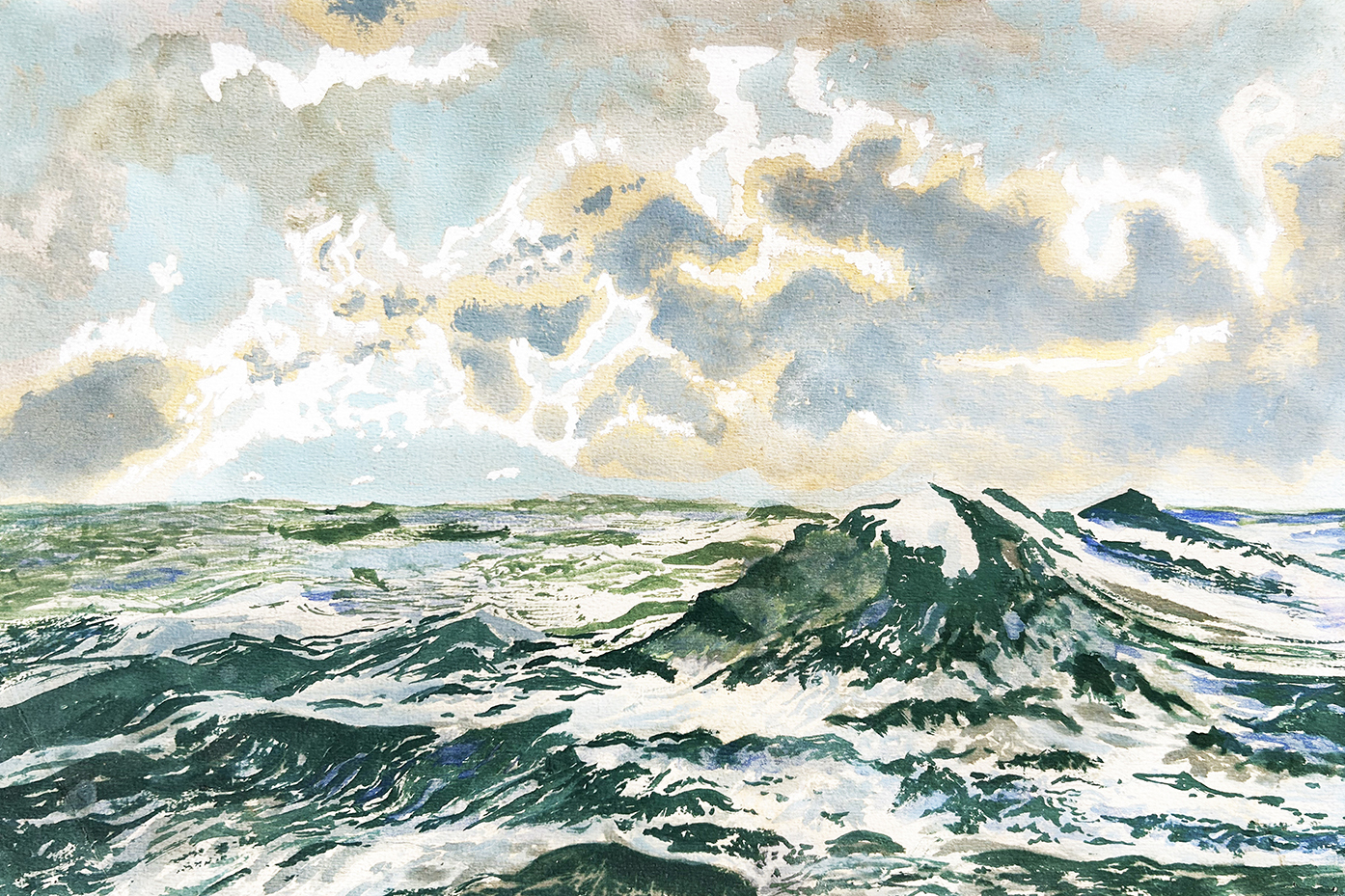The beauty of God’s creation
by Warren L. Maye

One clear and starry night, an adolescent’s life–long love of God’s creation began. That evening in Ohio, he lay on his back on a comfortable blanket in the middle of an open field. To his amazement, he would soon fathom the heavens and, at the same time, explore the mysteries of his own mind.
Other young students also carpeted the field. They were in for the most astounding camping experience of their lives. “Just put your hands behind your head and focus your eyes on the sky above you,” said the instructor. Softspoken, thin, and grey haired, he was nonetheless the popular meteorologist Dick Goddard of WJW–TV, and the first weather reporter in Cleveland, Ohio, to ever hold such a degree.
Under Goddard’s careful guidance, the cohort had already spent days investigating the woods. They had conducted nature experiments of all kinds. They had measured rainwater accumulated in tin cans on the ground. They also gathered rain from troughs that circled the trunks of selected trees.
They had driven stakes in the ground and had tied strong lines to divide several acres into quadrants. Then they carefully counted the specific and various forms of wildlife that lived in each square of land. Birds, bees, flowers, trees, and even mosquitos were included in their meticulous calculations.
Each day, the class recorded changes in humidity. They did this by measuring the length of a single strand of hair, taken from each of their own heads. Each strand was gently suspended and stretched by a small weight. On dry days, the hairs would be longer, and on wet days, the same hairs would shrink and become slightly shorter. Every day, the boys and girls judiciously noted the length of the hairs and used that precise data to determine the humidity pattern for the week.

But on this dark and quiet night, their exploration would assume an unfathomable dimension, one that has remained vividly clear in the boy’s mind to this day. “What do you see?” Goddard asked. “The sky!” “Stars!” were typical answers from everyone. “Is that all? Just keep watching,” he said.
Seconds, then minutes passed as the sky grew even darker. If something doesn’t happen soon, I’m going to fall asleep out here, the boy thought. Finally, what seemed like a miracle, happened. “I see something moving!” shouted a student. “Whe, whe, where?” the boy asked.
His question seemed to echo across the field as other kids also wanted to know. “Over there!” another student said. His voice crackled with excitement. “Over there!”
It had taken a while, but their eyes, now adjusted to the low light conditions, were focused on the heavens. What had looked like tiny, fuzzy lights, now took on the appearance of brilliant diamonds in the sky, their many facets, sparkling.
“What is that thing, moving?” asked a girl.
The weatherman said, “That’s a manmade satellite. You can tell a satellite from a star or a planet because it moves so fast!” Sure enough, the little white dot hastily made its way along a straight and steady path.
“Look again,” he said. “What else can you see?”
With exceptional clarity, the boy now saw as if binoculars had replaced his eyes. “I, I, I see the stars!” he said. “Goddard asked, “What colors do you see?
The boy thought, do stars have color? Goddard said, “Cool stars burn blue. Red stars burn brighter because they are hotter. What color do you think even hotter stars burn?” “Oh, oh, orange?” the boy asked. “Yes! Orange, yellow, and white hot!” Goddard said.
The more the boy looked, the more he saw. Yes, there were colorful stars up there, like lights on a Christmas tree.
“Now, planets are different,” the weatherman said. “Can anyone point one out?” Aside from the moon, the boy didn’t believe that seeing a planet would be possible with his naked eye. Nonetheless, the meteorologist continued, “Do you see that bright, steady light over there?” They all looked, and to their amazement, said “yes.” Goddard explained that the students were seeing planet Venus. Rather than twinkle like a star, it firmly reflected the Sun’s light.

By this time, the boy felt he had seen everything. But what came next was mesmerizing. It forever changed his perspective on the universe.
Fully engrossed now, his mind took him to another place in time and space. He imagined himself looking down on the twinkling stars, the bright planets, and the moving satellites, rather than up at them. At that moment, he felt as if the only thing that kept him from falling into an infinite abyss was the sure gravity that held him flat and resolute against the earth.
The boy felt goosebumps rise, and his heartbeat quicken. Will I freefall into eternity? he thought. His body inhaled compulsorily, and the night air rushed into his expanded lungs.

In that cosmic moment, God appeared as an epiphany and revealed a small portion of His majesty. The boy was comforted in the knowledge that, despite the vastness of sky, he felt nonetheless safe in God’s care. “Thank you, Lord!” he said in a steady voice. It was the first time he spoke that clearly in almost two years since the shooting.

After returning home from his summer camp adventure, the boy’s greatest desire was to maintain his exciting understanding of nature. How can I do it? he wondered. One night in his bedroom, God revealed the answer.
On his activity table were little tubs of watercolor paint, brushes of various sizes, and pads of soft, absorbent paper. He had gotten those supplies after surviving the event that had literally left him speechless.
God’s grace had spared his life from a mass shooter, but the trauma had caused him to stutter terribly, every time he spoke. A kind neighbor had suggested, “If you can’t say it, write it down; if you can’t write it down, draw a picture.”
Woodland Hills Park was about two miles from the boy’s home. So, on a clear and sunny day, he filled his backpack with paints, brushes, water bottles, pads, an easel, and lunch and began his first of many treks to the park.

He loved the challenge of painting illu-minated trees. When the wind blew, the hues changed. The brilliant rays of sun and deep shadows fascinated him. An azure sky, feathery clouds, and soft intermittent breezes served as a fitting milieu.
As evening came, the horizon turned fiery red and then purple. Feeling satisfied in his soul, the boy quickly finished his last painting for the day, gathered his supplies, and walked home.
From watercolors to acrylics to oil paint- ings, the boy continued to capture the beauty of God’s creation on pads, boards, and stretched linen canvases. As time went by, he felt spiritually and emotionally healed with every brush stroke.
As the fledgling artist’s voice eventually returned, the frightening memories grew dim: of “Old Papa Ricks’” .22 caliber rifle barrel pointed between the boy’s widened eyes, his friend’s mouth agape, and the mysteri- ous little man who seemed to appear from nowhere who said, “He’s not one of them,” just as Papa Ricks was about to pull the trigger.
As years went by, this teenager grew in stature and in favor. He continued to paint, draw, and write. The memories of shots fired, the images of and screams from youths running and falling, were gradually replaced by comforting words of prayer, and a desire to capture as art, God’s miraculous creation.

Charles R. Gordon, M.D., author of In Plain Sight: Seeing God’s Signature throughout Creation, writes, “Our universe is amazing and incomprehensible. Unfathomable. Yet the more we peer into it, the more we find the fingerprints of an Original Artist. The trick is to know the Artist’s signature when you see it.”
Today, I look back on those days with gratitude to God who is the Original Artist. After spending many years as a painter, a writer, and now a magazine editor, I can connect the cosmic dots that lit my God–ordained path. I can see clearly how evidence of God’s creation gave me the spiritual discipline to search for Him during that nebulous time in my life.

Many contemporary Christian thought leaders call for the Creation Story to be told in its entirety. Ken Ham is the founder, CEO, and former president of Answers in Genesis, a Christian apol- ogetics organization that operates the Creation Museum and the Ark Encounter. He alerts church leaders and laypersons that a low view of Genesis among Christians is rendering the Church ineffec- tive at evangelizing our modern world.
Ham stresses that the story arc, from the fall of man in the Garden of Eden to the death and resurrection of Christ at Calvary, must be told as history rather than as a fairytale. He agrees that it must also be told with authority before the message of Salvation can truly make sense to today’s skeptical and often Godless generation.
Read more from the latest issue of SAconnects.


